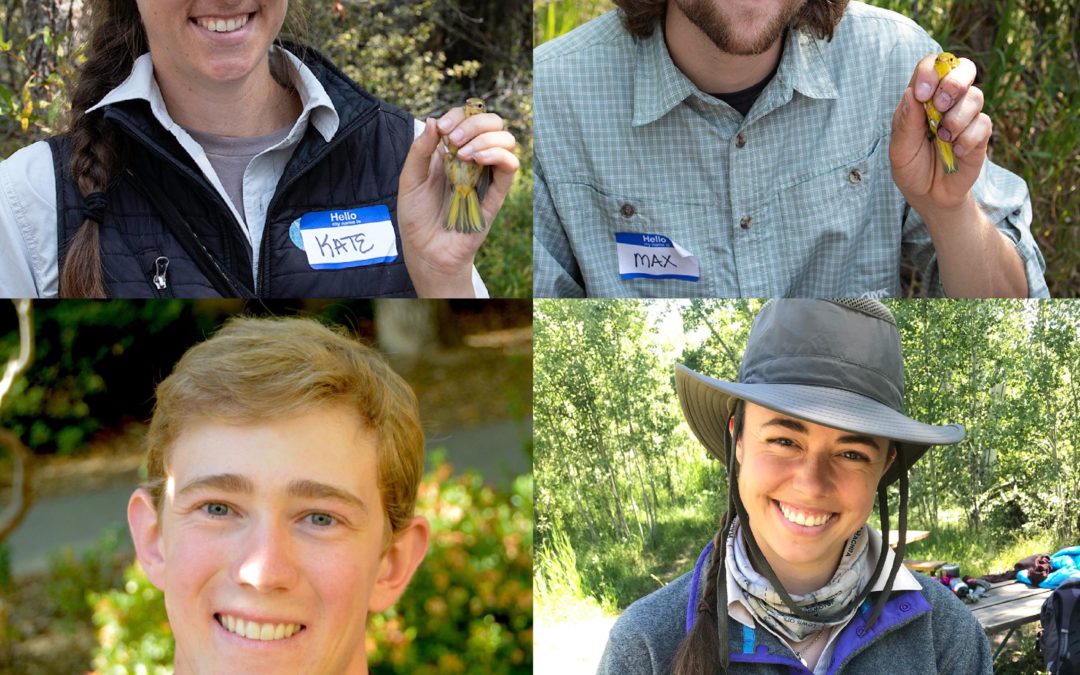
by jhwildlife | Aug 30, 2018 | Blog
As the summer comes to an end, we have to say goodbye to our seasonal field staff. This group of amazing individuals helped collect data, led the Monitoring Avian Productivity and Survivorship (MAPS) project, banded Mountain Bluebirds, organized volunteers and produced written and visual content to support our core programs. We hope that in the future we are able to get a group of individuals who are as passionate and dedicated as this crew was. We wish them the best as they move forward in their promising careers.
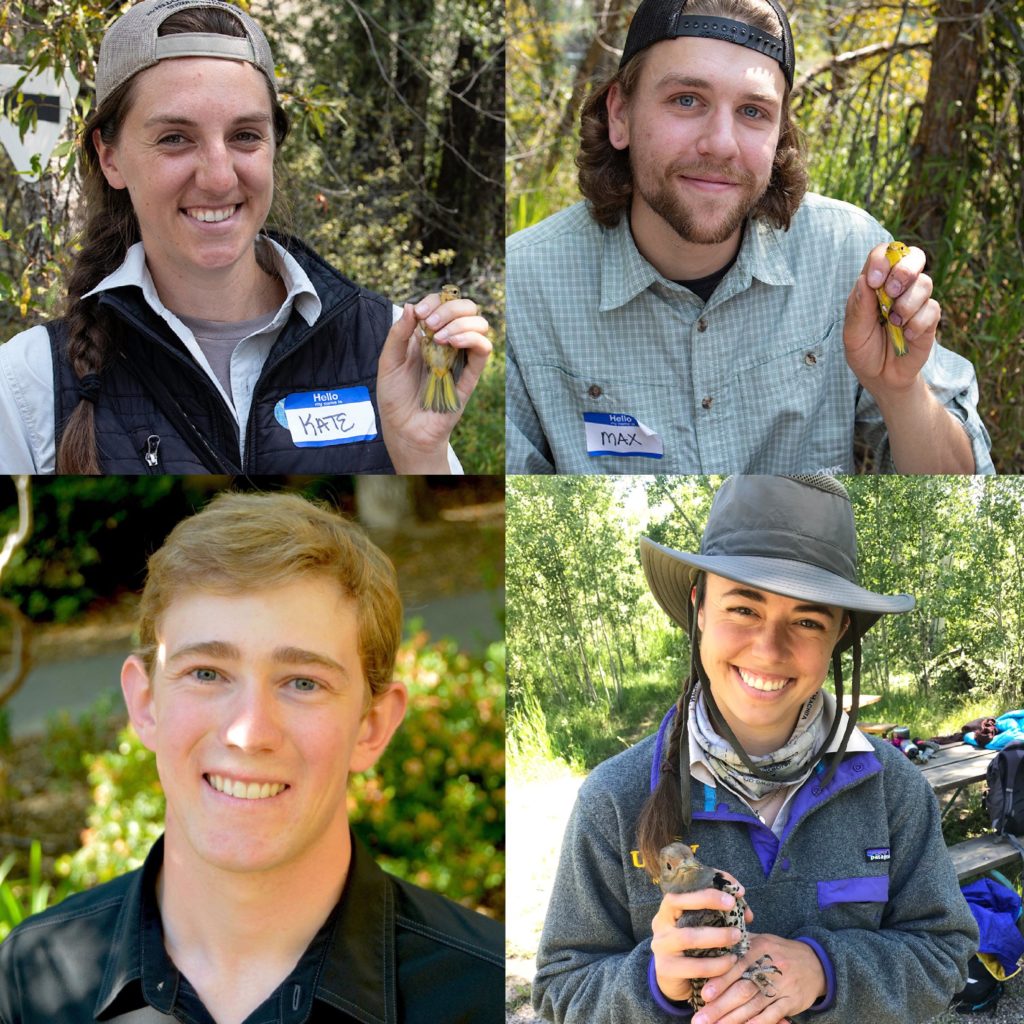
Here’s a bit about where each is going next:
Lead Bird Bander Kate Maley (top left) is headed to the Midwest to band owls at Hawk Ridge Bird Observatory in Duluth, Minnesota. This long-term research station primarily looks at Northern Saw-whet Owls in hopes of learning about migration and population demographics.
Assistant Bird Bander Max Frankenberry (top right) is headed to Casper, Wyoming to help conduct eagle surveys at wind energy sites, in hopes of lowering mortality rates while promoting compatibility between new energy technology and wildlife. Max will also be helping conduct a bumblebee study with the USGS.
Summer Intern Victoria Hollingsworth (lower right) is headed over the hill to live in Victor, Idaho in hopes of pursuing a job in outdoor and art education. She is looking forward to meeting new people and continuing her passions.
Summer Intern Tyler McIntosh’s (lower left) next stop is the big island of Hawaii, where he will help organize and teach an environmental field science program for undergraduate students. He is excited about the opportunity to continue developing his skills as an educator and passing along his passion for the natural world. He also won’t complain about exploring the Hawaiian reefs and beaches! In the future, Tyler hopes to work on conservation and management issues with non-profits and government agencies in the American West. He seeks to integrate community-engaged decision making with conservation research while providing meaningful educational opportunities.
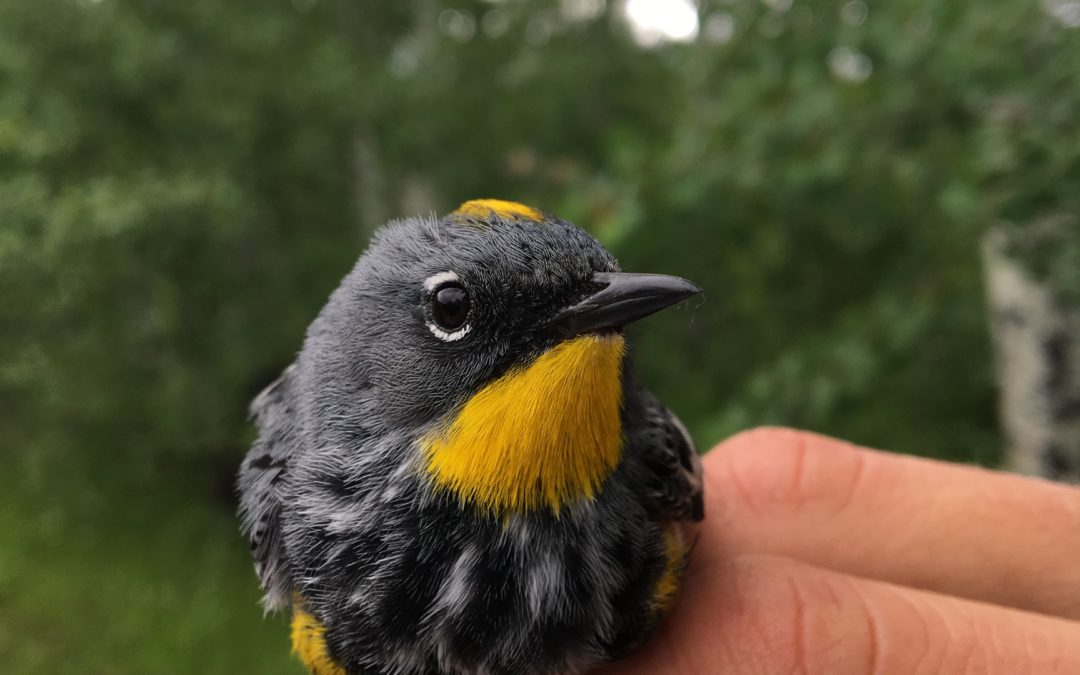
by jhwildlife | Aug 24, 2018 | Blog
by Max Frankenberry, Assistant Bird Bander
After nine weeks of banding birds this summer, JHWF’s first MAPS season has officially come to an end. Every Wednesday and Friday sunrise, from June 6th to August 3rd, was spent setting up nets, collecting data on the birds we caught, and attaching small aluminum USGS-issued bands to their legs. All in all, this season produced 677 total bird captures, with 453 new birds banded this season.
Bird banding is a highly-effective research method used worldwide for tracking bird movement, survival rates, and reproduction success. Banders are trained in specialized bird handling, safety, and data collection, and can only legally band birds if covered under state and federal permits. Each band number is unique to each individual bird. Banders report both new bands placed on previously unbanned birds, and bands that are on birds that they recapture after already being banded before. Other data like age, sex, weight, and various conditions are also collected and reported, forming the massive database of information that USGS and various ornithological groups manage and analyze.
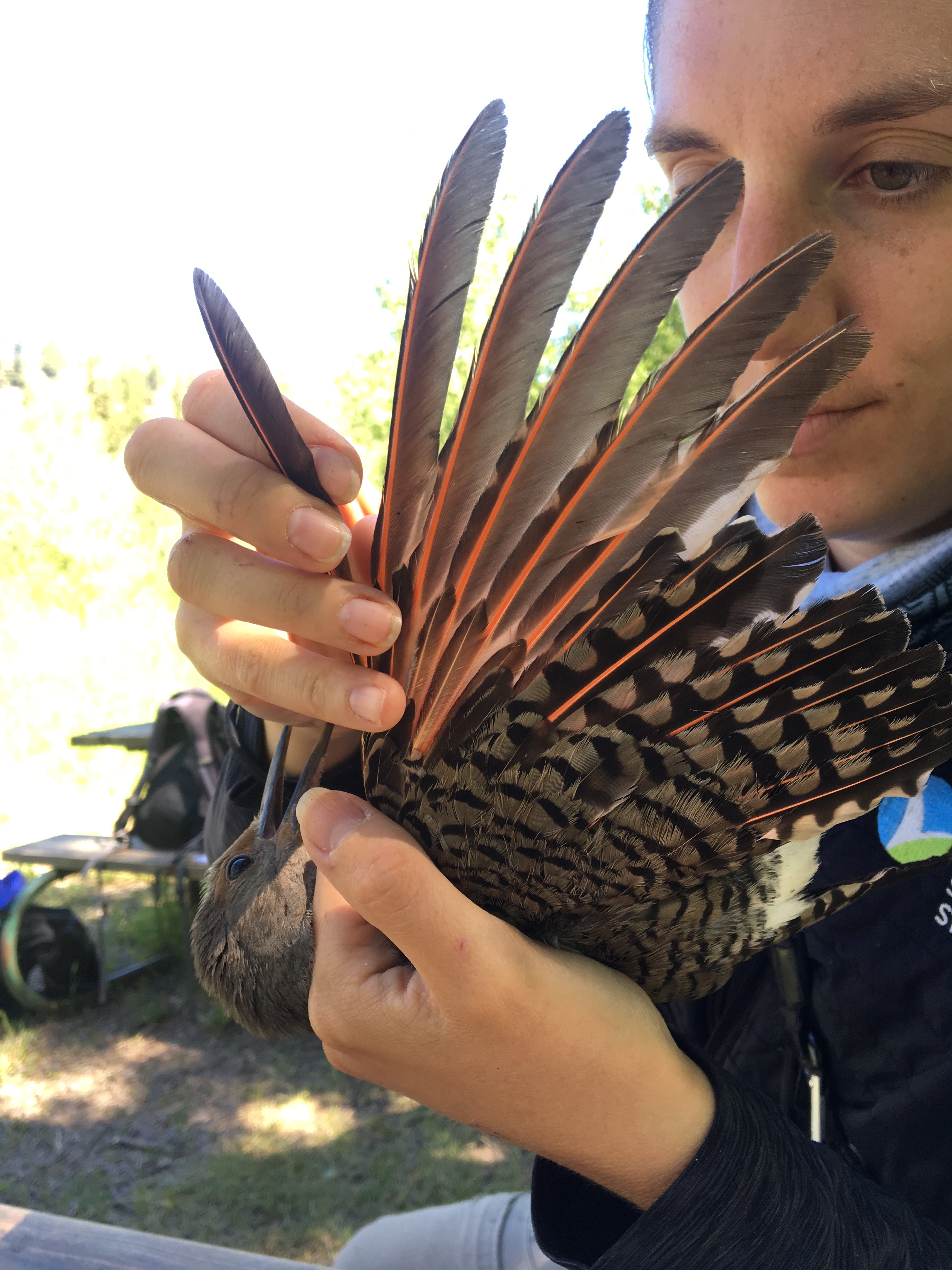
Lead Bird Bander Kate Maley attempts to age this Red-shafter Flicker (Colaptes auratus) by inspecting flight feather characteristics
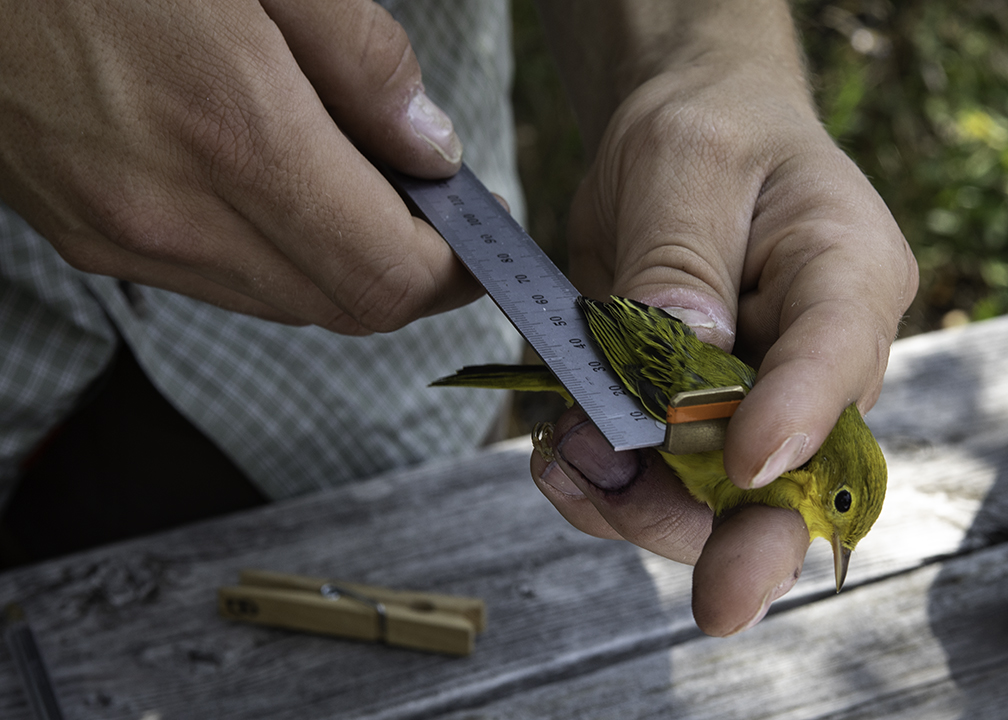
Assistant Bird Bander Max Frankenberry measures the wing chord length of a Yellow Warbler (Setophaga petechia) Photo credit: David Hopkins
MAPS stands for Monitoring Avian Productivity and Survivorship. It is a specific banding program begun by the Institute for Bird Populations (IBP), with a goal of better understanding survival rate and nesting success while birds are at their summer breeding grounds. JHWF bands birds following IBP protocol — opening nets at sunrise and closing them six hours later — and submits data to the IBP database. This builds on the years of previous data collected on birds in Jackson Hole from Teton Science Schools (TSS) and Teton Raptor Center (TRC), who helped transition the program to us this year. Our two banding locations, Teton Science Schools’ Kelly campus and Boyle’s Hill on their Jackson campus, have been contributing data without a break in observations for 28 and 16 years respectively. Kelly is one of the longest operating MAPS stations in the country! Long-term, uninterrupted data sets are crucial to understanding trends in bird population shifts. Thanks again to TSS and TRC for making the transitions between organizations so smooth!
The 2018 season ended with 180 recaptures (out of 677 total captures) of previously banded birds, with several of these birds having been banded even before the 2017 season. Much like years before and not surprising to those of us that live in Jackson Hole, our most popular species caught were Yellow Warblers and American Robins (AMROs). In total, 109 new Yellow Warblers (or YEWAs in banding code) had bands placed on their legs this year, many of them young birds born this summer. YEWAs are doing just fine in our valley! American Robins were our second most common bird this year, with 57 new birds banded. While we had constant flows of incoming YEWAs and AMROs, we also had a few particularly exciting individuals as well. By far the most unexpected were a pair of Belted Kingfishers, each caught a week apart from each other! While kingfishers are not uncommon here, they are rarely caught in banding stations, mostly due to their preference for flying much higher than the nets and perching on trees overhanging water.
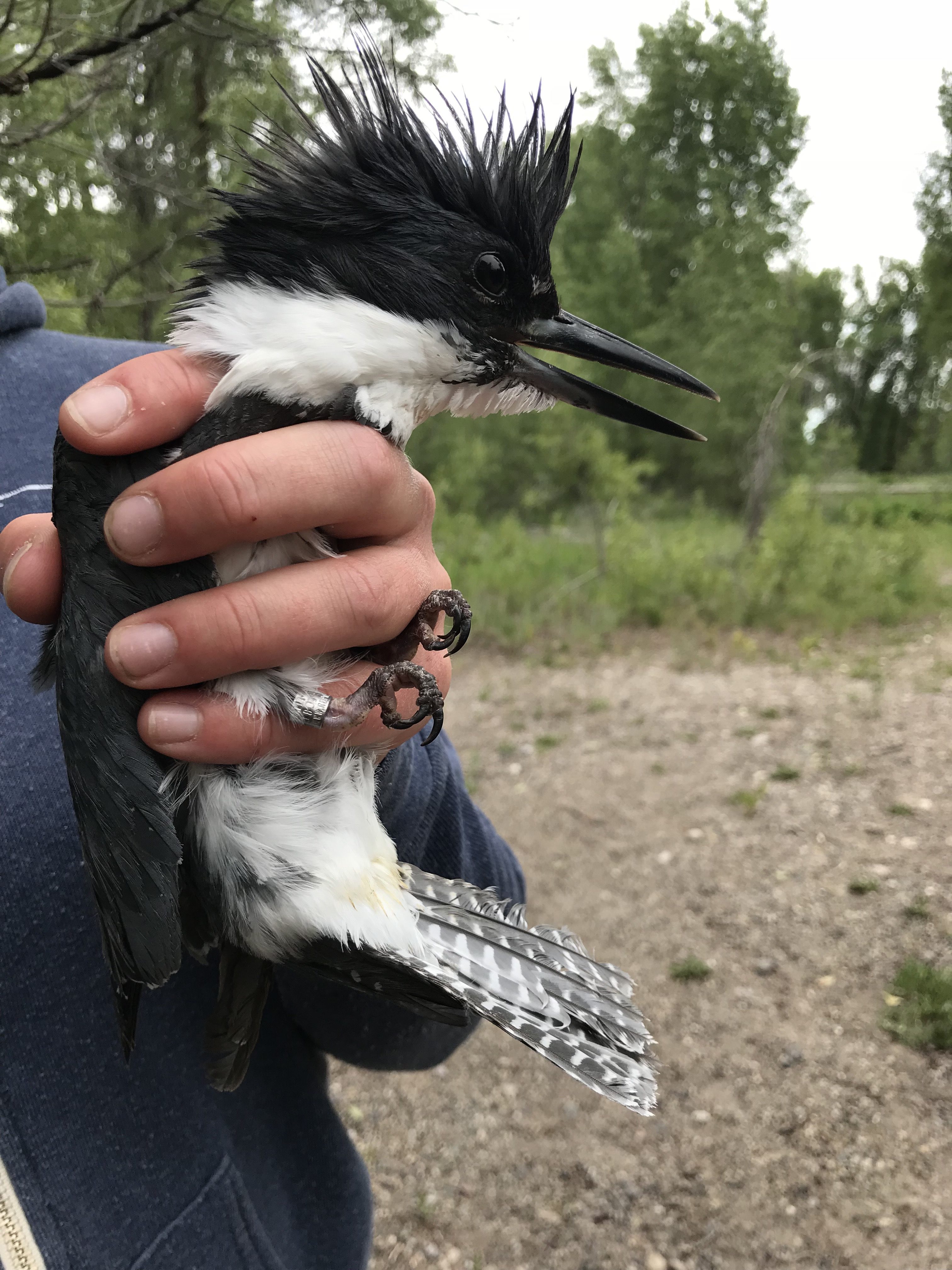
Male Belted Kingfisher (Megaceryle alcyon)
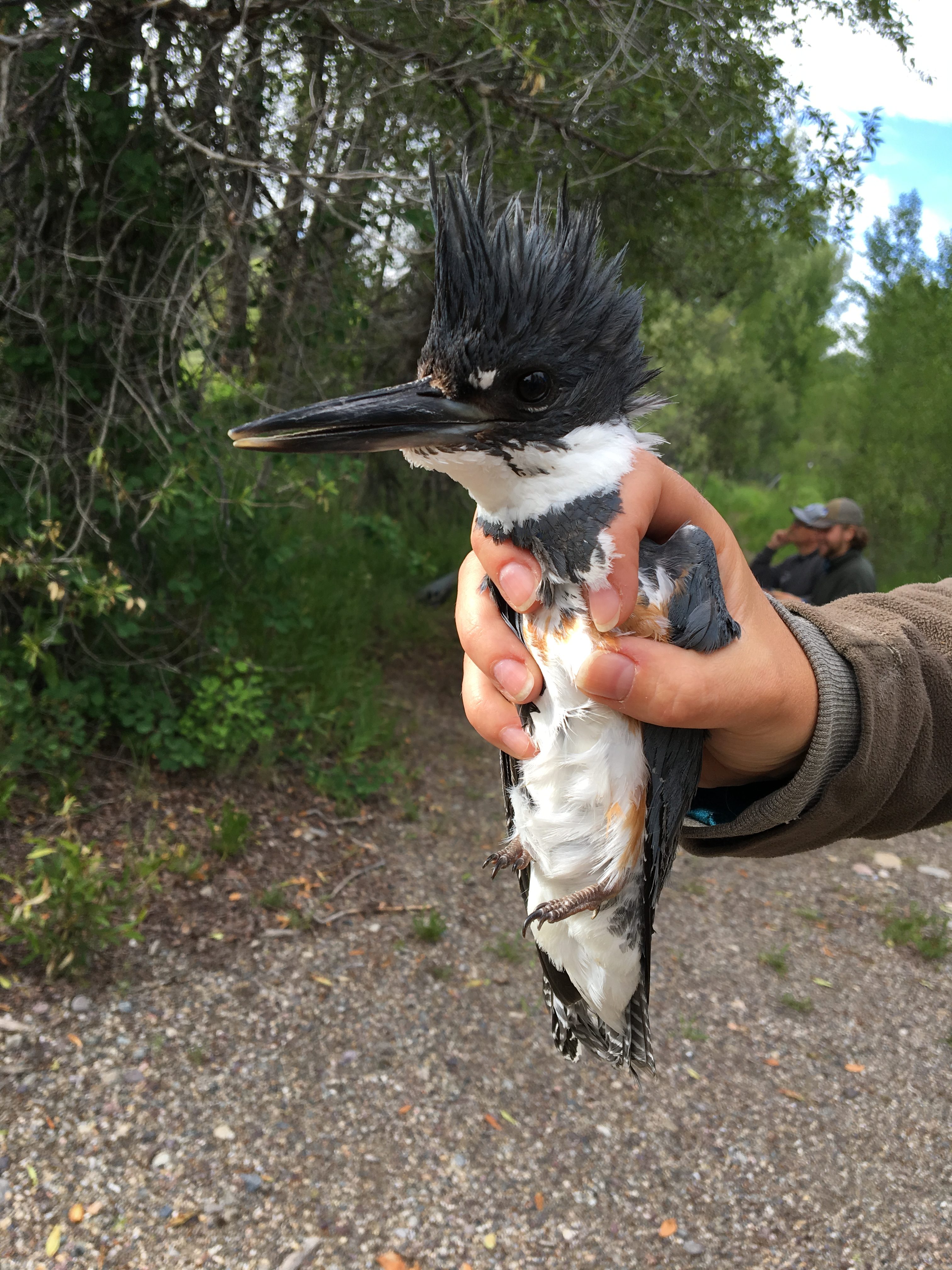
Female Belted Kingfishers have a rusty belly band (Megaceryle alcyon)
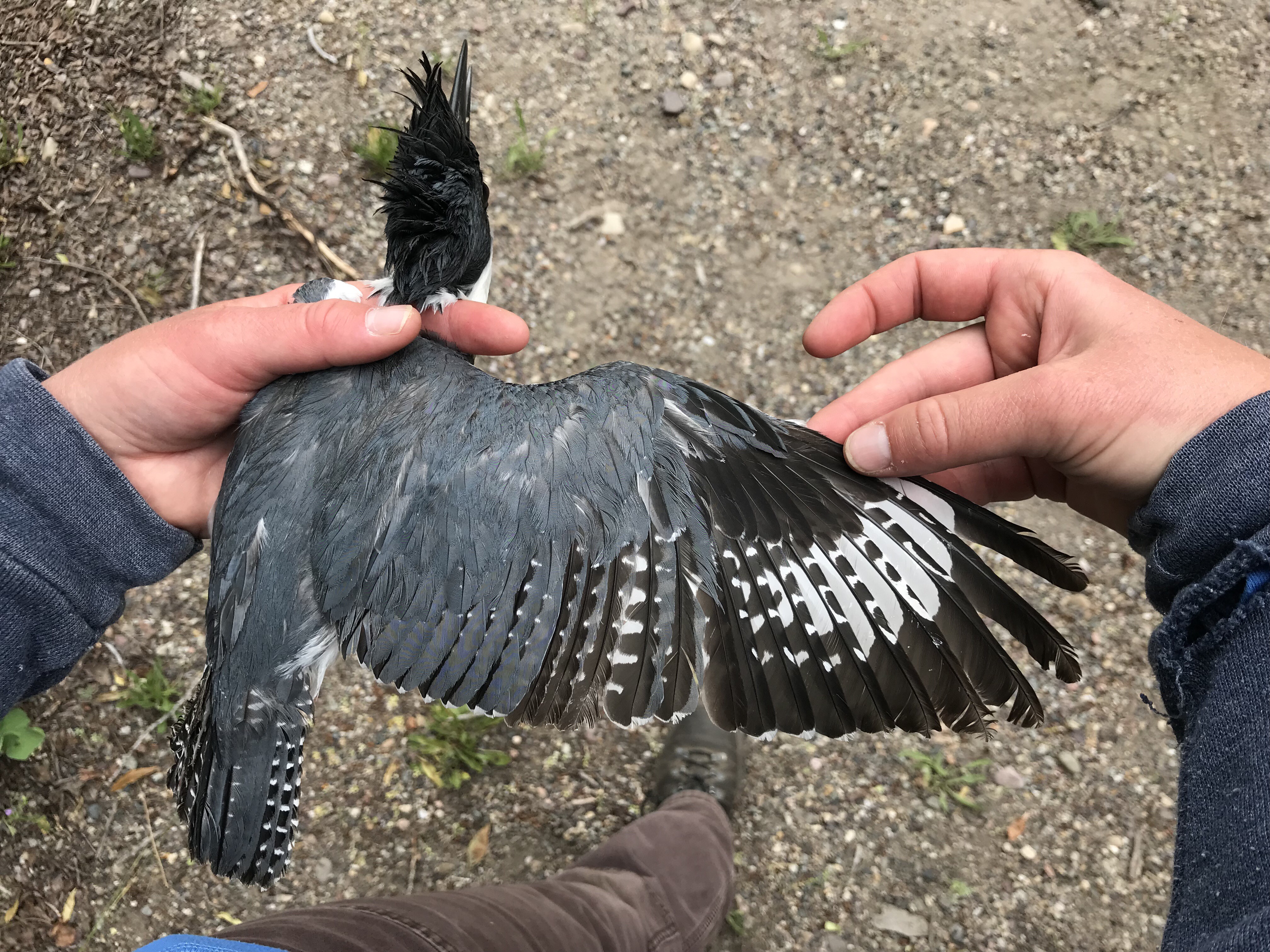
Belted Kingfishers have detailed white patterns on their flight feathers – we can use these to figure out how old the birds are!
We were excited to say the least. Other species that graced us with their surprising presence were a very vocal Olive-sided Flycatcher and a juvenile Brown Creeper. We also had 40 birds that were captured and released but not banded, including large number of Rufous, Calliope and Broad-tailed Hummingbirds (our banding permit does not allow hummingbird banding – that requires additional specialized training). Overall we captured 45 different species of birds over 9 weeks. This guaranteed that we never had a slow morning at either banding station!
Other wildlife sightings always kept us on our toes throughout the season – early mornings at Kelly and Boyle’s Hill allowed us views of several moose and calves, foxes, a grizzly bear, a family of otters, and even an elusive mountain lion! Sunrise work with birds in the Greater Yellowstone Ecosystem meant bear spray and our favorite badly-sung show tunes had to always be at the ready.
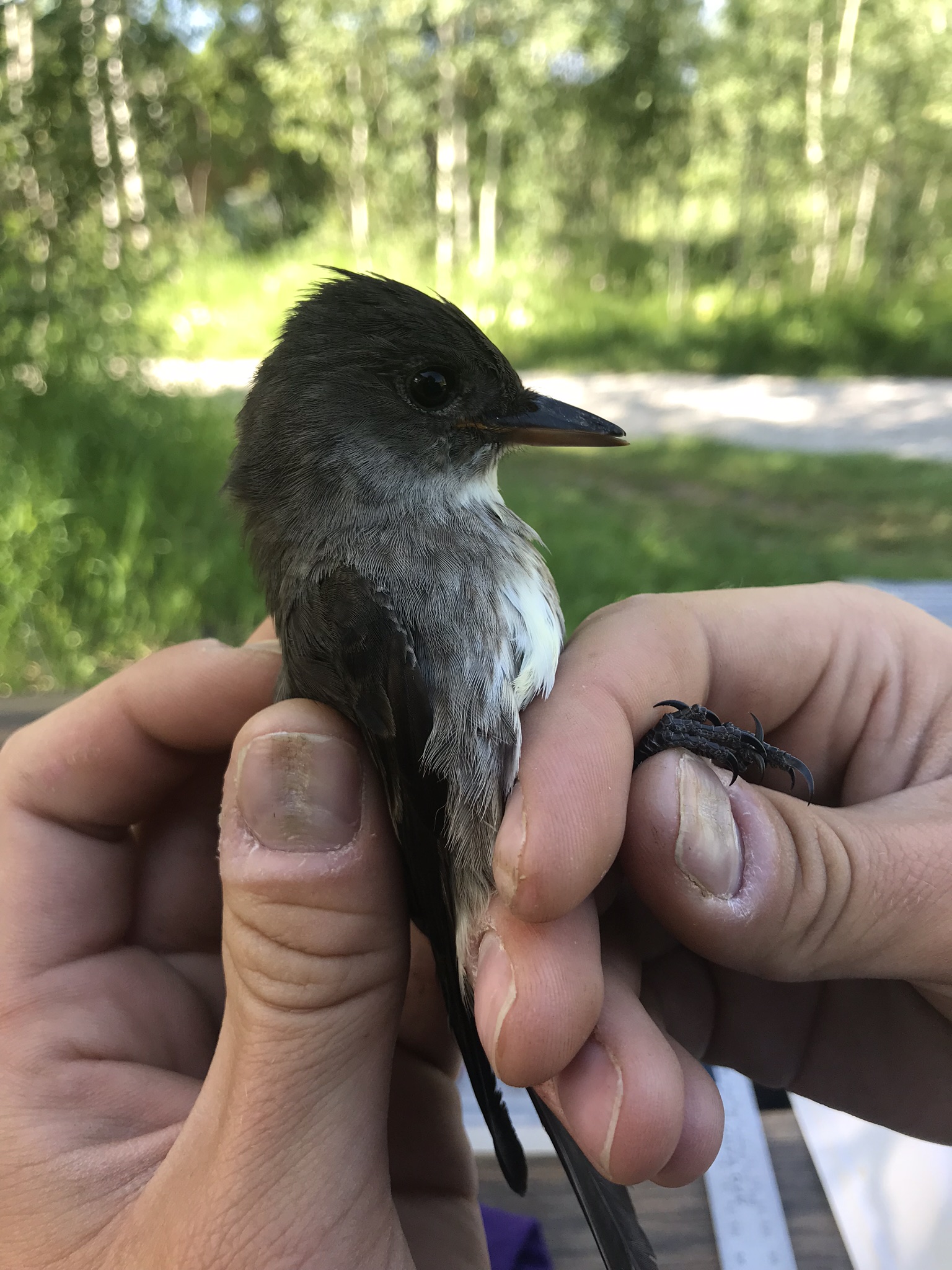
Olive-sided Flycatcher (Contopus cooperi)

Male Black-headed Grosbeak (Pheucticus melanocephalus)
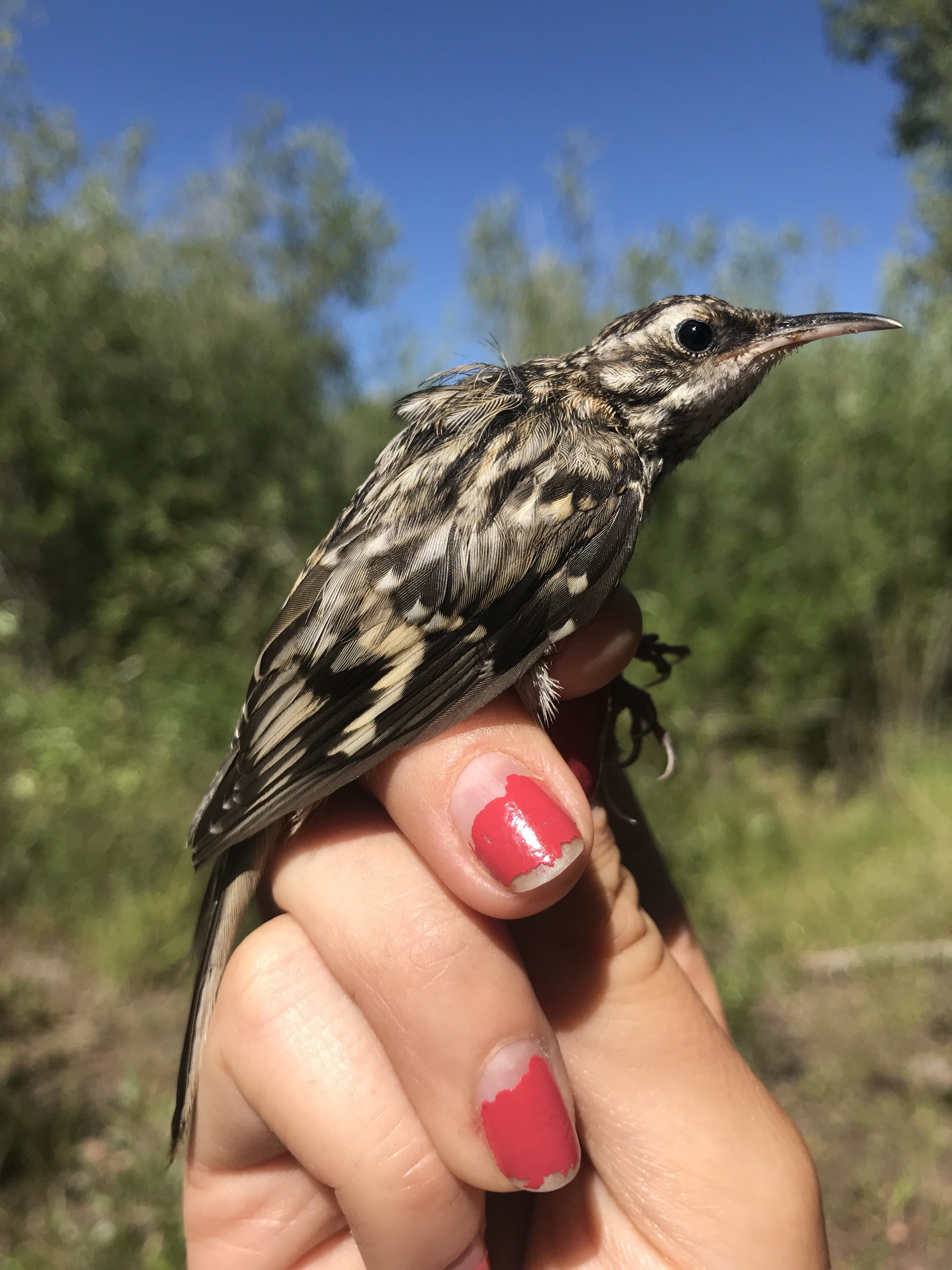
Juvenile Brown Creeper (Certhia americana)
We want to thank all who have made this program possible. This effort to track birds in our valley really does contribute extremely valuable data to a great continent-wide program. The MAPS data has resulted in many highly regarded publications on the state of bird populations in North America and new ways to manage and preserve them. Thanks for being “for the birds”!
Below is a full list of the species we captured and banded this season. Look them up and try to spot some of them in your own backyard!
- Calliope Hummingbird
- Broad-tailed Hummingbird
- Rufous Hummingbird
- Belted Kingfisher
- Red-naped Sapsucker
- Downy Woodpecker
- Red-shafted Flicker
- Olive-Sided Flycatcher
- Western Wood-Pewee
- Willow Flycatcher
- Dusky Flycatcher
- Warbling Vireo
- Violet-Green Swallow
- Black-Capped Chickadee
- Mountain Chickadee
- Red-breasted Nuthatch
- White-breasted Nuthatch
- Brown Creeper
- House Wren
- Golden-crowned Kinglet
- Ruby-crowned Kinglet
- American Robin
- Swainson’s Thrush
- Hermit Thrush
- Gray Catbird
- Cedar Waxwing
- Orange-crowned Warbler
- Yellow Warbler
- Audubon’s Warbler
- MacGillivray’s Warbler
- Wilson’s Warbler
- Western Tanager
- Black-headed Grosbeak
- Green-tailed Towhee
- Brewer’s Sparrow
- Chipping Sparrow
- Mountain White-Crowned Sparrow
- Fox Sparrow
- Song Sparrow
- Dark-eyed Junco
- Brown-headed Cowbird
- Bullock’s Oriole
- Cassin’s Finch
- Pine Siskin
- American Goldfinch
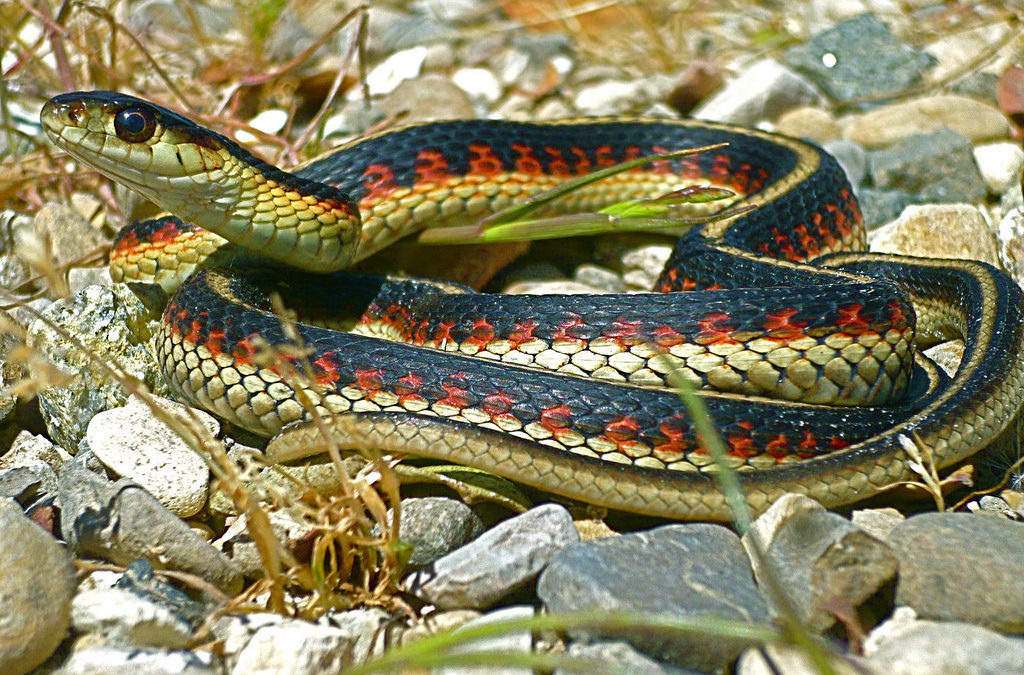
by jhwildlife | Aug 24, 2018 | Blog
GUEST BLOG: The Jackson Hole Wildlife Foundation asked our friends and fellow Nature Mappers, Betty and Chuck Mulcahy to share a bit with us about their current volunteer work at the National Elk Refuge. Betty and Chuck do a lot to educate the public about the wonders of snakes and demystify their wicked reputation. Don’t be afraid, read on and learn about our serpent friends:
“Count the snakes and keep your distance!” a friend warned in an email after we told her our new assignment for biological work on the National Elk Refuge was to survey reptiles, mainly counting the snakes.
Unknown to her, the snakes in Jackson Hole are comprised of three non-venomous species. Because one species, the rubber boa, is nocturnal, we don’t expect to encounter it on our rounds, although our biologist mentioned he had seen one once during the day.
The other two species are the wandering gartersnake and the valley gartersnake. The wandering gartersnake is the more numerous and is unlikely to bite if picked up. Instead, this species prefers to defend itself by exuding a musk in your hand, much like pooping. As we tell school children when we present a reptile program in their classrooms, this defense is very effective due to the pungent odor! Their response is always the same: “Eeeeeew!”
However, locating snakes on 25,000 acres can be tricky – perhaps likened to searching for the proverbial needle in a haystack. Our long-time mentor in snake locating is a Denver Zoo reptile keeper, as well as rattlesnake researcher, who can find a snake with the ease of a professional.
In the past, we have spotted snakes on top of Miller Butte, thermoregulating across roads, swimming in creeks, and hiding in sidewalk cracks and under steps. Now, scouring the Refuge, we flip rocks, turn logs, lift tarps, and trudge through thick vegetation in our search.
Because snakes have yet to be surveyed on the Refuge, no precedent is set for their documentation. Consequently, we outline our search area on a map and record date and findings in a comment section. Finding nothing is as important to record as our successes, according to our biologist, as is recording any dead serpents.
While the wandering gartersnake can often be found at a distance from water, the valley gartersnake is found more often near water and is believed to have declined in population over the years.
We hope to encounter each of these species!
̶ Betty and Chuck Mulcahy

To keep up-to-date on Betty and Chuck’s survey and other adventures you can follow along via their blog Have Snakes Will Travel: The Unconventional Lives of Volunteer Naturalists.
For more detailed information including photographs on the three snake species found in Teton County, WY visit the following links:
- Northern Rubber Boa – Charina bottae – looks like a fake rubber snake, with its lack of distinctive head or tail or any markings. In Wyoming, it is found only in the mountainous northwestern region.
- Wandering Gartersnake – Thamnophis elegans vagrans – is by far the most common gartersnake in Teton County and ranges across the state. The body background color varies from brown to olive, and the stripes and markings can vary in intensity, but it will not have red.
- The Valley Gartersnake – Thamnophis elegans fitchi – has a very limited range in Wyoming: the very western edge of Teton and Lincoln Counties. It is distinctive from the Wandering Gartersnake by its red accents.

by jhwildlife | Aug 23, 2018 | Blog
by Kate Maley, Lead Bird Bander
Since Chuck Schneebeck started the Bluebird Trail in 2003, members of the Jackson community have endeavored to create nesting habitat for Mountain Bluebirds and other native cavity-nesters along the southwestern edge of the National Elk Refuge. After many years of observation and data collection, at least one thing is clear: the birds are definitely using the nestboxes! But what effect are the boxes having on the population?
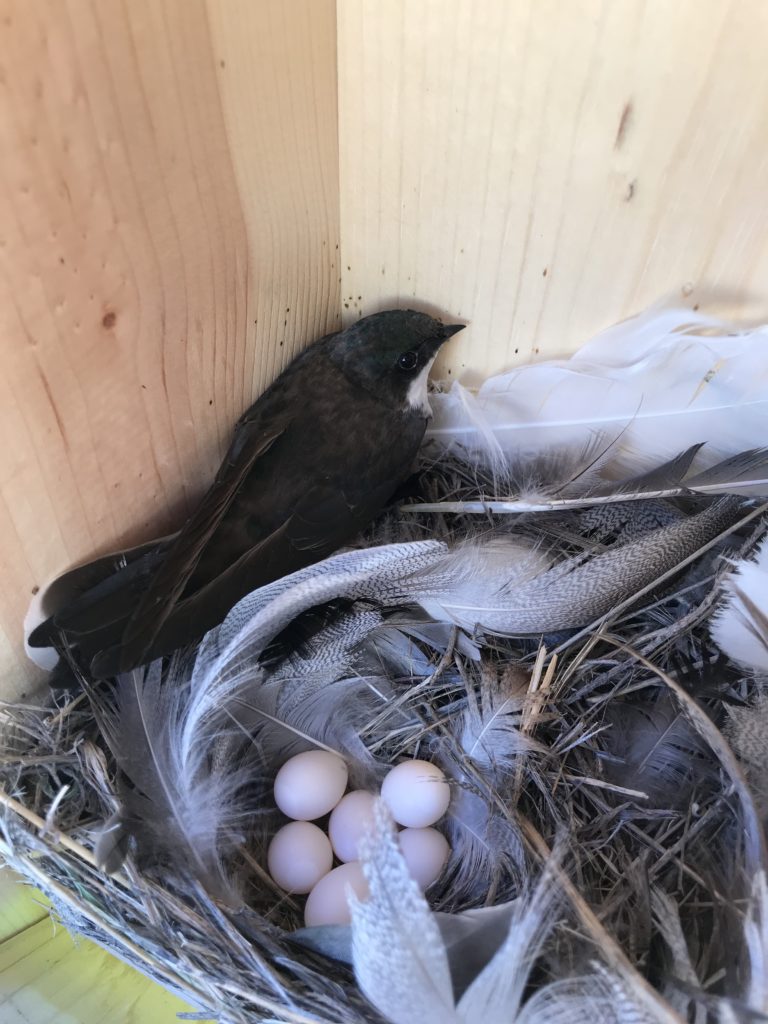
While we focus on Mountain Bluebirds, we are equally pleased to see other native cavity nesters using the nestboxes! Tree Swallows are the most abundant nesters along the Bluebird Trail, though they arrive after most bluebirds have settled into their territories for the season.
Jackson Update:
In 2017, JHWF began expanding upon the existing data and investigating new questions when our previous bander Allison Swan and monitoring volunteers started placing USGS aluminum bands and a unique series of color bands on Mountain Bluebird nestlings and one adult female. These color bands, or “bling,” allow us to identify each individual bird as it disperses from its nest and, hopefully, returns to a similar area the following year to raise some little bluebirds of its own!
Still in the early stages of the banding project, we don’t have many definitive answers yet, but we are learning lots! Of the 98 bluebird nestlings that were banded in 2017, only a handful have been resighted this year. This isn’t as surprising as it may initially sound, however. The first year of a bird’s life is the hardest as they learn to fend for themselves and navigate migration. Optimistically, we estimate that around 50% or fewer birds make it back to their breeding grounds in their second year. Once back in Jackson Hole, they disperse from their original nest site to independently begin a family of their own. Where do they go? That’s one of the things we’re hoping to discover!

Max Frankenberry, Assistant Bander, secures the color bands on a nestling to help ensure they will stay on and be able to be spotted next year.
While migration is still a taxing journey for adult bluebirds, they do benefit from experience. In addition, adult bluebirds tend to have higher site fidelity, meaning they are more likely to return to the same site to breed for multiple years. So far, the one banded adult mountain bluebird did, in fact, return to the exact same nestbox where she was banded in 2017!
Admittedly, 2018 was a tough year for nestbox inhabitants as almost half of the nestboxes were within a stretch affected by predation events. (Exact numbers are still being determined as we close out the season and compile the data.) In response, we placed a number of predator guards that are recommended by the North American Bluebird Society. Fortunately, most of the guards did seem to effectively prevent the depredation of a second nesting attempt. Even with the challenge of a predator, nearly all of the 112 available nestboxes were occupied by native cavity nesters (Mountain Bluebirds, Tree Swallows and House Wrens). Of the Mountain Bluebird nests, about 75% successfully fledged young. In total, 72 nestlings were banded in 13 nestboxes (some had two broods throughout the season).
Now, we’ve reached the point in the season when bluebirds of all ages disperse from their nest sites and seem to gather into groups by age to take advantage of the last of summer’s bounty and fatten up before migration. So, if you keep an eye out for “Bluebirds with Bling,” you’re likely to see some from the 2018 cohort (indicated by a peach color band on the bird’s right leg, closest to the body) and possibly some from 2017 as they group up prior to beginning journey south.
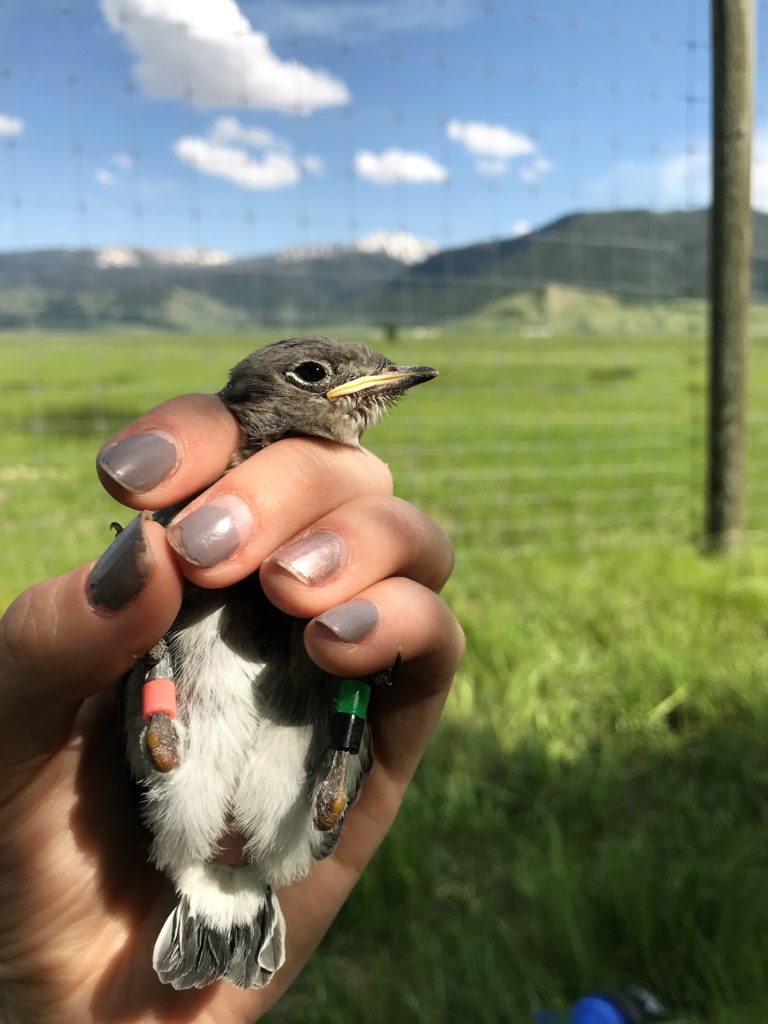
Meet one of the members of 2018’s cohort of bluebirds! The location of the peach color band (top right) will allow us to easily identify it as having hatched and been banded this year. Left: Black over Green, Right: Peach over Silver
Dubois Update:
Last year was also the first year of the Dubois Community Bluebird Trail. The project continued in 2018 with 35 nestboxes monitored by 9 volunteers. We’re still waiting to finalize the data prior to analyzing the results from the season, but we’re looking forward to what we find out!
Thank you to all our hardworking volunteers and partners in both Jackson and Dubois who make this project possible!
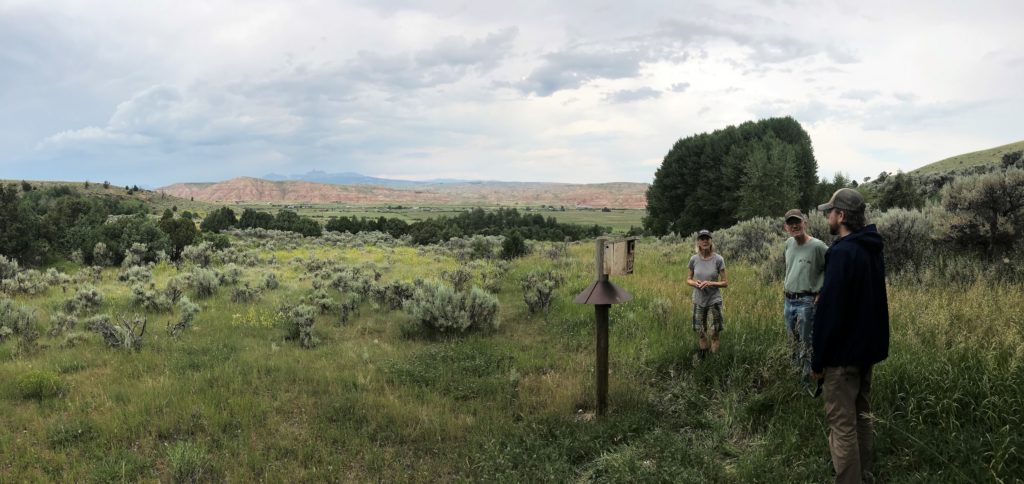
Nancy and Blair Butterfield were kind enough to give us an update and tour of their nestboxes when we visited Dubois in July.

by jhwildlife | Aug 17, 2018 | Blog, Wildlife Friendlier Landscapes
by Jon Mobeck, Executive Director
For 25 years, Jackson Hole Wildlife Foundation (JHWF) has worked to reduce human-caused impacts on wildlife. One of our most visible programs, Wildlife Friendlier Fencing, began in 1996 when a small group of local citizens and JHWF founders organized group fence pulls on Saturdays. Over the course of the next two decades, hundreds of individuals (almost entirely volunteers) helped to remove or modify almost 200 miles of fence. There have been so many key contributors that it would be unwieldy to list them all here, but we recognize two of them today for their dedicated efforts in the field, and for their legacies that inspire our work well after their lives were ended much too soon.
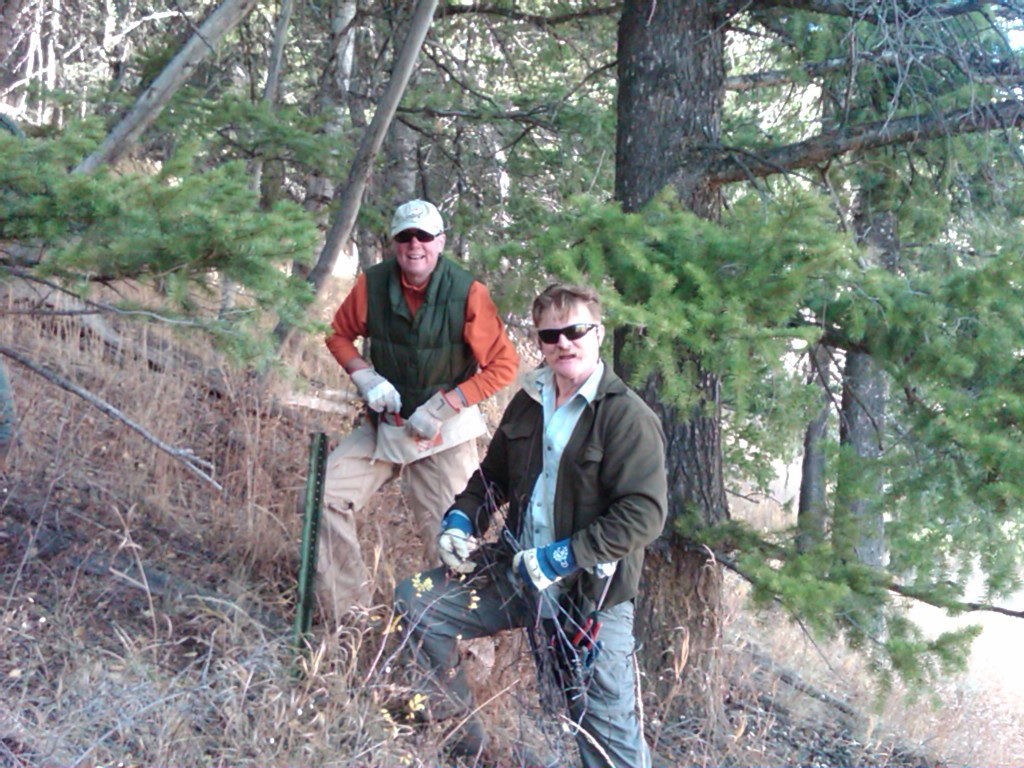
Sue Colligan (left) and Greg Griffith were invaluable contributors to the Wildlife Friendlier Fencing program for many years.
Sue Colligan was the Executive Director of the Jackson Hole Wildlife Foundation less than a decade ago, and all who remember her speak to her incredible dedication to the fence program. My personal recollection of Sue was as a member of an early incarnation of the Safe Wildlife Crossings for Jackson Hole group in 2011-2012. While I represented The Murie Center for that purpose, Sue advocated for wildlife on behalf of JHWF. At those meetings (in Vance Carruth’s living room), Sue used her voice effectively and with intelligent precision. I think she could say in 20 words what I convey in 100. Those who joined her on fence pulls have also spoken about her steady resolve to get things done for wildlife. When Sue’s illness took her life too soon, she left a legacy gift to JHWF to continue its essential work. With those funds, we have been able to purchase supplies for the Wildlife Friendlier Fencing program, and in 2018 we used funds left by Sue to purchase a work truck, which has been used extensively to support our Wildlife Friendlier Fencing program (it carries tools and gear to every project) and our Nature Mapping Jackson Hole program (it carries bird banding supplies, mist nets and gear to field sites weekly throughout the summer.)
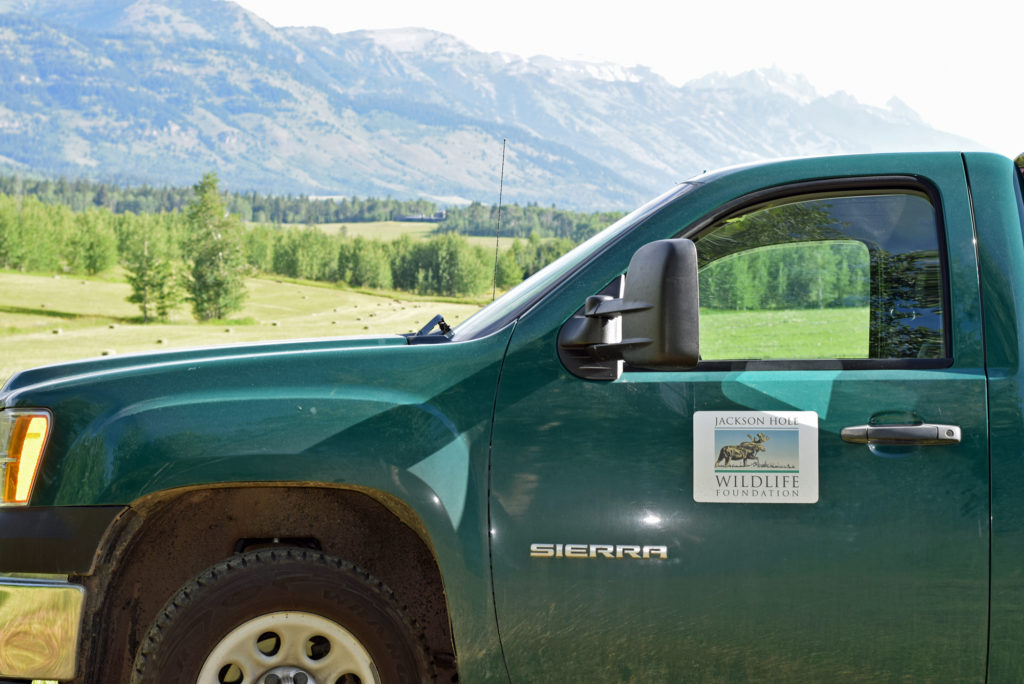
The Jackson Hole Wildlife Foundation truck sits ready for work at a Wildlife Friendlier Fencing project site in front of the Tetons.
Greg Griffith is known to many in Jackson as the unstoppable engine of the Wildlife Friendlier Fencing program for many years. A car accident took Greg from us very prematurely, but rarely a fence project goes by without someone mentioning Greg – his specific project methods, his concern for other volunteers, his fierce commitment to doing what is best for wildlife. Stories about Greg are now the stuff of legend, except there’s no indication that any of the stories are exaggerated, as many legends are. If someone says that he once carried six full rolls of barbed wire down a mountain and across a raging river, I’d have to believe it. It must have happened just that way. While I never met Greg, I feel that I know him through these stories, through the many volunteers who were deeply affected by him. When Greg passed, friends from far and wide made donations to JHWF in his honor. Now almost three years later, we still receive notes and occasional donations that reference Greg’s impact. He improved the lives of people as he made our valley better for wildlife. With the donations made in Greg’s name, JHWF purchased a cargo trailer to house all of our fencing tools and other JHWF field supplies. In the near future, we will place a graphic wrap on the trailer that promotes the program and the work of the many volunteers who have contributed to its success over the years.
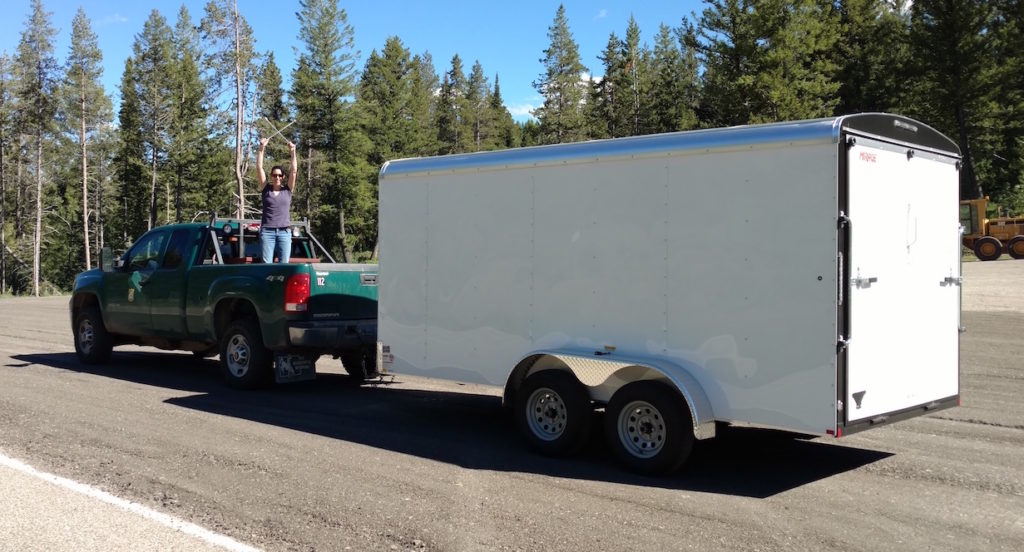
JHWF Board President Aly Courtemanch delivers the new cargo trailer to the JHWF office.
There are many people to celebrate in the history of the Jackson Hole Wildlife Foundation, likely none of whom really care to be celebrated. Many have done the work quietly and doggedly, on Saturdays, in the heat, in the rain. Whatever it has taken to get the job done. The legacy that follows all of these individuals is one of humble service to the wild community, to which we belong. May it ever be so.

by jhwildlife | Aug 15, 2018 | Blog
by Jon Mobeck, Executive Director
Across all of our programs, Jackson Hole Wildlife Foundation works to reduce human-caused impacts on wildlife. The negative impacts of roads are well documented, at least as it relates to vehicle collisions with large mammals. Less discussed is the impact on birds, although we know that impact to be significant. Teton Raptor Center admits more birds that have been struck by vehicles than any other source of injury. Some can be rehabilitated. Many cannot.

Raptor mortalities from vehicle strikes are not uncommon. On August 15, a hatch year Osprey was killed by a recreational vehicle on WY 22, not too far from a nest platform designed to support life for these magnificent raptors. The location of the collision was also not far from a digital message sign warning drivers that young Osprey may be on the road. The reason for the warning is that a fledgling Osprey may take a few weeks to take flight after initially leaving the nest. Its learning curve can include erratic flight, much like a toddler’s first wobbling steps. As many of us know in Jackson Hole, Osprey nest platforms are often near highways, and like many other raptors, Osprey also perch on electrical poles. Because of these realities, it is essential that drivers understand the potential for collisions with these beautiful birds during this short summer window, hence the educational messaging on the signs that typically alert drivers only to the likely presence of elk, deer or moose. Osprey are a dazzling, conspicuous bird, and just as you would slow your speed if you saw an elk in the highway right-of-way, alert drivers can greatly reduce the likelihood of collision with these raptors by temporarily slowing speeds to watch for imminent flight in these areas.
There is no guaranteed solution for eliminating raptor deaths on the roadways. Wildlife crossing structures that can facilitate ungulate movement over or under a highway are of no help to birds. Signage and education can help generally, and real-time actions, such as temporary digital messaging near nest sites, can alert many, if not all drivers to the presence of young birds. Every action counts. Give Birds a Brake!


























